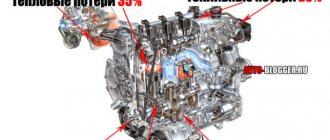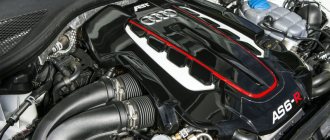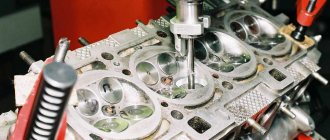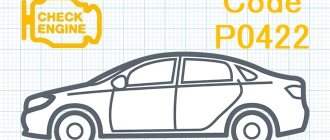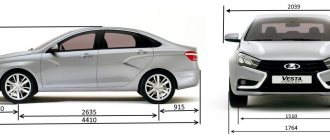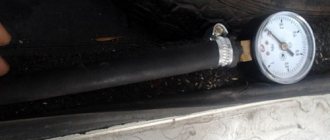Guides
Author temass
Date
Jul 18, 2017
7,980
Share
Among the many useful characteristics, engine efficiency is of no small importance. The duration and efficiency of the power unit depends on this indicator.
- Efficiency of an internal combustion engine - what is it?
- Power losses - where and why
- Comparison of efficiency of heat engines - gasoline and diesel
- Asynchronous motor and stirling
- Maximum efficiency value of an ideal engine
- How to increase efficiency?
More about losses
Looking ahead, we can confidently say that the efficiency of a gasoline engine ranges from 20 to 25%. And there are many reasons for this. If we take the incoming fuel and convert it into percentages, then we seem to get “100% of the energy” that is transferred to the engine, and then there are losses:
1) Fuel efficiency . Not all the fuel is burned, a small part of it goes with the exhaust gases, at this level we already lose up to 25% efficiency. Of course, now fuel systems are improving, an injector has appeared, but it is far from ideal.
2) The second is thermal losses and . The engine warms itself and many other elements, such as radiators, its body, and the liquid that circulates in it. Also, some of the heat leaves with exhaust gases. All this results in up to 35% loss of efficiency.
3) The third is mechanical losses . ON all kinds of pistons, connecting rods, rings - all places where there is friction. This can also include losses from the load of the generator, for example, the more electricity the generator generates, the more it slows down the rotation of the crankshaft. Of course, lubricants have also made progress, but again, no one has yet been able to completely overcome friction - losses are still 20%.
Thus, the bottom line is that the efficiency is about 20%! Of course, among the gasoline options, there are standout options in which this figure is increased to 25%, but there are not many of them.
That is, if your car consumes fuel 10 liters per 100 km, then only 2 liters of them will go directly to work, and the rest are losses!
Of course, you can increase the power, for example, by boring the head, watch a short video.
If you remember the formula, it turns out:
This is interesting: Brake slave cylinder - how to prevent major troubles?
What is efficiency? Let's understand what efficiency is
Blue LEDs are needed to produce white light in combination with red and green. These two colors were learned to be produced in sufficiently bright LEDs much earlier; blue ones have long remained too dim and expensive for mass use. Another example of effective but very expensive devices is solar cells based on gallium arsenide (a semiconductor with the formula GaAs). Their efficiency reaches almost 30%, which is one and a half to two times higher than the batteries used on Earth based on the much more common silicon. High efficiency only pays off in space, where delivering one kilogram of cargo can cost almost as much as a kilogram of gold. Then the savings on battery weight will be justified.
The efficiency of power lines can be increased by replacing copper with better-conducting silver, but silver cables are too expensive and therefore are used only in isolated cases. But the idea of building superconducting power lines from expensive rare-earth ceramics that require cooling with liquid nitrogen has been approached in practice several times in recent years. In particular, such a cable has already been laid and connected in the German city of Essen. It is designed for 40 megawatts of electrical power at a voltage of ten kilovolts. In addition to the fact that heating losses are reduced to zero (however, in return it is necessary to power cryogenic installations), such a cable is much more compact than usual and due to this you can save on the purchase of expensive land in the city center or refuse to lay additional tunnels.
Not according to general rules
Many people remember from school courses that efficiency cannot exceed 100% and that the greater the temperature difference between the refrigerator and the heater, the higher it is. However, this is true only for the so-called heat engines: steam engine, internal combustion engine, jet and rocket engines, gas and steam turbines.
Electric motors and all electrical devices do not obey this rule, since they are not heat engines. For them, the only thing that is true is that the efficiency cannot exceed one hundred percent, and particular restrictions in each case are determined differently.
In the case of a solar battery, losses are determined both by quantum effects during the absorption of photons, and by losses due to the reflection of light from the surface of the battery and to absorption in the focusing mirrors. The calculations showed that in principle a solar battery cannot go beyond 90%, but in practice values of about 60-70% are achievable, and even those with a very complex structure of photocells.
Fuel cells have excellent efficiency. These devices receive certain substances that react chemically with each other and produce an electric current. This process, again, is not a cycle of a heat engine, so the efficiency is quite high, about 60%, while a diesel or gasoline engine usually does not go beyond 50%.
It was the fuel cells that were installed on the Apollo spacecraft that flew to the Moon, and they can run, for example, on hydrogen and oxygen. Their only drawback is that the hydrogen must be quite pure and, moreover, it must be stored somewhere and somehow transferred from the plant to consumers. Technologies that make it possible to replace ordinary methane with hydrogen have not yet been brought to mass use. Only experimental cars and a few submarines run on hydrogen and fuel cells.
Engine thermal efficiency. Not so scary physics.
Typically, if someone hears the slogan “engine thermal efficiency,” they immediately change the topic. You can talk about engines about their power, about their fuel consumption or - earning the respect of your interlocutors as an expert - about performance systems such as Diesel, Otto, Wankel and Atkinson. But thermal efficiency sounds like physics homework, that is, it causes disgust and negative reactions. Meanwhile, all this merges into one...
Engine efficiency - denoted by the Latin symbol η (eta) - is a parameter that characterizes a given engine and means how much supplied heat is converted into useful work. In the case of an internal combustion engine, this is the conversion of thermal energy resulting from the combustion of fuel into mechanical energy released by the engine as a result of the rotation of the crankshaft.
The values of this efficiency vary for different types of engines and, for example, for spark-ignition engines it is about 0.30–0.36, and for diesel engines it is about 0.40–0.45. This means nothing more than that when filling a tank with 50 liters of fuel, only 15-18 liters of gasoline and 20-22.5 liters of diesel fuel are used to drive the vehicle components. The rest is irretrievably lost.
Steam engine efficiency
To operate the power unit, it is necessary to convert the thermal energy generated by the combustion of the air-fuel mixture into mechanical energy. Previously, steam engines were used in which solid fuel (coal, firewood) was burned, the pistons were set in motion under the influence of expanding steam. The dimensions of such power plants were several times larger in size than modern engines running on other types of fuel.
In piston-type steam engines, the efficiency does not exceed 10%. Currently, such devices are almost never used, since it is believed that there are no fundamental ways to increase their efficiency.
In order to increase this indicator, heat sources with the lowest cost are used. For example, large thermal power plants use nuclear energy. In addition, modern technologies are used in which waste heat does not go uselessly into the atmosphere, but is used for heating systems in apartment buildings. The losses here are no more than 10 percent. Modern steam turbines have an efficiency coefficient of 50 - 60%.
Power losses - where and why
- fuel efficiency - the fuel does not burn completely, a small part of it simply flies out into the exhaust pipe. At this stage, 25% is lost;
- thermal - the engine heats not only itself, but also its other elements. To obtain heat, energy is required, this is loss. Another 35% is spent on them;
- mechanical - friction occurs during the movement of mechanisms. Of course, lubricants weaken its effect, but it has not yet been possible to completely defeat it. That's another 20%.
- Google+
- LJ
- Blogger
At the output we find that the engine efficiency is only 20-25%. In fact, if a car consumes 10 liters of gasoline per 100 km, then only 2 liters will be spent on work, the rest is losses.
Which engine has the highest efficiency?
Now I want to talk about gasoline and diesel options, and find out which of them is the most efficient.
To put it in simple language and without getting into the weeds of technical terms, if you compare the two efficiencies of gasoline and diesel units, the more efficient of them is, of course, diesel and here’s why:
1) A gasoline engine converts only 25% of energy into mechanical energy, but a diesel engine converts about 40%.
2) If you equip a diesel type with turbocharging, you can achieve an efficiency of 50-53%, and this is very significant.
So why is it so effective? It's simple - despite the similar type of work (both are internal combustion units), diesel does its job much more efficiently. It has greater compression, and the fuel ignites using a different principle. It heats up less, which means there is a saving on cooling, it has fewer valves (saving on friction), and it also does not have the usual ignition coils and spark plugs, which means it does not require additional energy costs from the generator. It operates at lower speeds, there is no need to frantically spin the crankshaft - all this makes the diesel version a champion in terms of efficiency.
Comparison of efficiency of heat engines - gasoline and diesel
If we compare the useful power, we immediately note that the gasoline one is not as efficient. Its value is only 25-30%, while for diesel it is -40%.
Despite the similarity of the units, they have different types of mixture formation.
- In a gasoline engine, the pistons operate at higher temperatures, which requires good cooling. Therefore, thermal energy that could be transformed into mechanical energy is wasted, thereby reducing efficiency.
- In a diesel engine, the working mixture ignites during compression, so the pressure in the cylinders is much higher.
In addition, the motor is much smaller and more environmentally friendly. At low speeds and large displacement, efficiency levels can increase to 50%.
- Google+
- LJ
- Blogger
This is interesting: Welding a car body: how to do it yourself correctly
Formula for working in physics
For mechanical work, the formula is simple: A = F x S. If deciphered, it is equal to the applied force along the path along which this force acted. For example, we lift a load weighing 15 kg to a height of 2 meters. The mechanical work to overcome the force of gravity will be equal to F x S = mxgx S. That is, 15 x 9.8 x 2 = 294 J. If we are talking about the amount of heat, then A in this case is equal to the change in the amount of heat. For example, water was heated on the stove. Its internal energy has changed, it has increased by an amount equal to the product of the mass of water and the specific heat capacity by the number of degrees by which it has heated up.
Mechanism efficiency - what formula is used to calculate
Man has come up with various mechanisms that can be used to lift heavy loads to a certain height. Thus, a winch was invented to lift a bucket of water from a well, and a jack was invented to lift a car. Using a winch and an inclined plane, the Egyptians built their grandiose pyramids.
When using these devices, a person rarely remembers their efficiency. As an example, consider this indicator for an inclined plane .
The principle of calculating efficiency remains unchanged: you need to find the ratio of useful work to all energy expended. That is, again we use the general formula (1), making the appropriate transformations.
Suppose a body of mass m needs to be lifted (more precisely, pushed or pulled) to a height h. At a constant rate of ascent, the useful work will be equal to the product of gravity (mg) and height (h).
The work expended is determined by the arbitrariness of the push or pull force F on the length of the inclined plane L. Note that the push (traction) force is used to overcome the friction force Ftr.
Thus, the efficiency of such a simple mechanism can be calculated using the formula:
A simple analysis shows that the efficiency of an inclined plane is inversely proportional to the friction force and the length of the ramp. The latter, in turn, depends on the angle of inclination: the greater it is, the shorter the ramp.
Asynchronous motor and stirling
Today, asynchronous machines are presented on the market, most of which are electric. An asynchronous mechanism converts electrical energy into mechanical energy.
Their main advantages:
- ease of manufacture and relatively low cost;
- high reliability;
- operating costs are low.
- Google+
- LJ
- Blogger
The efficiency formula is calculated as follows: η = P2 / P1 = (P1 - (Pob - Ps - Pmx - Pd)) / P1, where Rob = Pob1 + Rob2 - the total losses in the windings of an asynchronous motor. For most modern mechanisms of this type, the coefficient reaches 80 - 90%.
Another internal combustion engine that can be powered by any heat source is the Stirling engine.
It should be noted that such mechanisms are used on spacecraft and modern submarines.
- Google+
- LJ
- Blogger
It operates at any temperature, does not require additional systems to start, and their efficiency is 50-70 higher than that of conventional engines.
Efficiency of an internal combustion engine - what is it?
During operation, the motor converts the thermal energy obtained from the combustion of fuel into mechanical work. Modern engines are much more efficient than those that were made 10 years ago. Thus, the efficiency is calculated based on technical characteristics, as well as other indicators.
Efficiency is the percentage of useful work to total work. In other words, it is the conversion of the power that goes to the engine's crankshaft to the power that the piston receives from the combustion of fuel.
WATCH THE VIDEO
All mechanisms are designed to perform a specific job, which is called useful. However, some of the energy is wasted. In order to find out the efficiency of work, the efficiency formula in physics is quite suitable: ɳ = A1/A2×100%, where A1 is the useful work performed by the machine or engine, A2 is all the work expended. In this case, the efficiency is denoted by the symbol η.
- Google+
- LJ
- Blogger
Efficiency efficiency is measured as a percentage and depends on various losses that occur during operation.
Electric motor efficiency and power
Efficiency and power are what you should first pay attention to when choosing an AIR asynchronous electric motor. The essence of the operation of any electric engine is that electrical energy, with accompanying losses, is converted into mechanical energy. The lower the losses during this process, the higher its efficiency and the more efficient the electric motor. But, despite the importance of efficiency, do not forget about the power of the motor. After all, even with extremely high efficiency and the power it produces, it may not be enough to solve the problems you need. Therefore, when purchasing, it is very important to know not only what the efficiency of the electric motor is, but also what useful power it can produce on its shaft. Both of these values must be specified by the manufacturer. Sometimes it happens that you don’t have access to the motor’s passport (for example, if you buy it secondhand, which is highly not recommended) and you have to independently calculate such important parameters. First, it’s worth defining what the coefficient of performance, or simply efficiency, is. And so, this is the ratio of useful work to energy expended.
Determination of electric motor efficiency
It turns out that in order to determine this parameter it is necessary to compare the energy it produces with the energy it needs to function. The efficiency is calculated using the expression:
η=P2/P1 where η is efficiency
P2 – useful mechanical power of the electric motor, W P1 – electrical power consumed by the motor, W;
Efficiency is a value ranging from 0 to 1; the closer its value is to unity, the better. Accordingly, if the efficiency has a value of 0.95, this shows that 95 percent of electrical energy will be converted into mechanical energy and only 5 percent will be losses. It is worth noting that efficiency is not a constant value, it can vary depending on the load, and it reaches its maximum at loads around 80 percent of the rated power, that is, that stated by the motor manufacturer. Modern asynchronous electric motors have a nominal efficiency (declared by the manufacturer) of 0.75 - 0.95. Losses during engine operation are mainly caused by heating of the motor (part of the consumed energy is released in the form of thermal energy), reactive currents, bearing friction and other negative factors. Motor power refers to the mechanical power that it produces on its shaft. In general, power is a parameter that shows how much work a mechanism does in a certain unit of time.
The efficiency of an electric motor is a very important parameter that determines, first of all, the efficiency of using the energy resources of an enterprise . As you know, the efficiency of an electric motor decreases significantly after its repair; we wrote about this in this article. As the efficiency decreases, electricity losses will correspondingly increase. Recently, energy-efficient electric motors from different manufacturers have been gaining popularity; in Russia, motors produced by Vladimir Electric Motor Plant OJSC are popular. Any asynchronous electric motors are presented in the product catalog. You can find additional useful information in the catalog of articles.
Is efficiency above 100% possible?
It's no secret that electric motors whose efficiency exceeds 100% cannot exist in nature, since this contradicts the basic law of conservation of energy. The fact is that energy cannot come from nowhere and disappear in the same way. Any engine needs an energy source: gasoline, electricity. However, gasoline does not last forever, just like electricity, because their reserves have to be replenished. But if there was an energy source that did not need replenishment, then it would be quite possible to create a motor with an efficiency of over 100%. Russian inventor Vladimir Chernyshov showed a description of a motor that is based on a permanent magnet, and its efficiency, as the inventor himself assures, is more than 100%.
Maximum efficiency value of an ideal engine
How to find the efficiency of an engine whose value would be ideal and equal to 100%. Is this possible? The answer to this question was given back in 1824 by engineer S. Carnot. In his developments, he came up with an ideal machine, where the formula for the efficiency of a heat engine looks like this: η = (T1 - T2)/ T1.
- Google+
- LJ
- Blogger
As a result, it was found that a 100% coefficient can be achieved only if the cooler temperature is equal to absolute zero, and this is impossible, since it cannot be lower than the air temperature.
How can you increase efficiency
Modern science is constantly looking for ways to increase the efficiency of engines and individual mechanisms, introducing new technical solutions and technological innovations.
The higher the efficiency, the more economical the engine will be, the more energy resources will be saved.
Heat engine
From formula (2) it follows that there are two ways : a) increasing the heater temperature; b) lowering the temperature of the refrigerator. Both paths are unpromising.
The heater cannot be heated indefinitely, since any material has a heat resistance limit. The refrigerator is almost always the environment, and introducing an additional heat exchanger (for example, a cylinder with liquid nitrogen) into the system is impractical: this will sharply increase the weight, dimensions and cost of the engine.
It has been established that the efficiency is not affected by the characteristics of the working fluid. What remains?
But there remain many practically feasible methods, such as reducing friction in mechanical components, minimizing heat loss by achieving the most complete combustion of fuel, creating streamlined shapes to reduce head-on comparison (air or water), etc.
an efficiency of 30-40% is currently considered a good indicator , scientists and practitioners have something to work on.
Power and torque
When the displacement figures are the same, the power of a naturally aspirated petrol engine is higher, but is only achieved at higher speeds. The unit needs to be “twisted” more strongly, while losses increase, and fuel consumption increases accordingly. In addition, it is worth mentioning torque, under the influence of which the force that is transmitted from the engine to the wheels increases and contributes to the movement of the car. Gasoline engines reach their maximum torque level only at high speeds.
An atmospheric diesel engine with the same parameters reaches peak torque only at low speeds. This contributes to less fuel consumption required to perform work, resulting in higher efficiency and more economical fuel consumption.
Compared to gasoline, diesel fuel generates more heat, since the combustion temperature of diesel fuel is much higher, which contributes to higher detonation resistance. It turns out that a diesel engine has much more useful work done on a specific amount of fuel.
The most common malfunctions of the diesel engine fuel system
Among the most common breakdowns in the diesel power system, the most common are the following:
- Difficulty starting the engine.
- Reduced power indicators.
- Increased fuel consumption.
- The appearance of smoke of various shades coming out of the exhaust pipe.
- Increased work rigidity.
- Inability to accelerate (in case of failures in acceleration, it is recommended to increase the accelerator pedal travel).
- Unstability of idle speed (floating).
- The engine stalls frequently.
Difficult start
To make it easier to start diesel engines in winter, manufacturers produce a special fuel called “Arctic”. However, the cause of difficult switching on is not always frozen diesel fuel. If it is impossible to start the diesel engine when cold, you need to check:
- quality of operation of high pressure pump discharge parts;
- degree of wear of injectors;
- adjusting the fuel advance angle;
- pre-start glow plugs;
- pressure regulator;
- leakage of fuel lines.
Power reduction
The power of a diesel engine decreases when malfunctions occur, fuel filters, or spray nozzle openings are clogged. When the filter elements fail, the amount of diesel fuel sent to the fuel pump is sharply reduced, which negatively affects the power performance of the engine.
Increased diesel fuel consumption
An incorrectly set injection timing is the main reason for high fuel consumption. The amount of fuel consumed is also affected by improper operation of the fuel injection pump. It is necessary to adjust the pressure level of the mixture at the time of injection. Reduced compression in the working cylinders can also cause increased diesel fuel consumption.
Exhaust black
If dark smoke appears from the exhaust system, it is recommended to check the quality of mixture formation. Violations can be caused by delayed injection of fuel, which does not have time to burn completely and settles on the cylinder walls in the form of soot. Layers of carbon also often form on valves that do not close tightly.
The appearance of white smoke in the form of steam does not cause alarm, because it quickly evaporates after the engine warms up. This can be observed especially often in diesel vehicles operating in areas of northern latitude.
Floating crankshaft speed in idle mode
For this defect you need:
- replace the sealing elements located under the nozzles;
- tighten the fuel wire connecting the filter to the injection pump;
- check the condition of the pump support plate;
- replace the crankshaft speed controller;
- check the operation of the ventilation system to eliminate gas pressure.
The engine stalls
If the motor often stops working while driving, you will need to check the following points:
- correct lead angle;
- quality of connections at the pump connection points;
- degree of filter contamination;
- displacement and distortion of high-pressure pump elements.
This is interesting
Science has proven that the efficiency of any mechanism is always less than one. This is due to the second law of thermodynamics.
For comparison, the efficiencies of various devices:
- hydroelectric power stations 93-95%;
- NPP – no more than 35%;
- thermal power plants – 25-40%;
- gasoline engine - about 20%;
- diesel engine - about 40%;
- electric kettle – more than 95%;
- electric vehicle – 88-95%.
Science and engineering do not stand still. Ways are constantly being invented to reduce heat loss, reduce friction between parts of the unit, and increase the energy efficiency of equipment.
Summary
In the production of modern internal combustion engines, manufacturing plants invest heavily in the pursuit of increasing the efficiency of their products by at least a few percent. To this end, engineers are improving and complicating motor designs and using new materials to manufacture individual elements.
Sometimes it happens that the financial costs of developers are inappropriate, in comparison with the obtained result of 2 - 3%. Therefore, it may be more profitable to subject standard engines to various boosts, fine-tuning, and modifications using tuning improvements in small repair shops. As a result, the power and other traction characteristics of power units increase.
Coefficient of performance (COP) is a widely used characteristic of the efficiency of some system or device. In our case, this system is the internal combustion engine. It would seem, what kind of efficiency can we talk about in the world of modern engines? Isn’t it equal to 100 percent? But it turns out that just as there is no ideal black or white in our world, there is no car in which all the energy received from burning fuel is completely converted into mechanical energy, and the latter, in turn, into useful energy that presses the driver of the car into his seat.
Causes of brake pedal failure
- A sharp drop in the level of brake fluid in the vehicle reservoir. In addition, the quality of the brake fluid used has a fairly large influence on the functioning of the brake pedal. Counterfeit brake fluid initiates swelling of brake hoses, delamination of their inner surface and, as a result, swelling of the cuffs of the master brake cylinder (hereinafter referred to as the brake master cylinder).
- Failures and malfunction of the GTZ. This is one of the most technically difficult problems, since in this case the entire assembly has to be changed.
- Consequences of incorrect replacement of brake components (brake pads, brake discs, etc.). Abnormal behavior of the brake pedal can be observed during the period of running-in of new elements, however, a violation of the “stiffness”, jerking and “beating” of the brake pedal is a direct indication for urgent diagnostics.
- Corrosion of the brake pedal or rods connected to it.
- Damage to the integrity of the accelerator pedal sensor.
- Incorrect adjustment of the gap between the pedal rod and the turbocharger. This is checked by gently pressing it with your hand. The absence of a change in the smoothness of the pedal indicates a discrepancy between the gap size and the established operational requirements.
- Failure of the vacuum pump or leakage of the hoses (cracks), which causes air to enter the brake system circuit.
About diesel fuel efficiency
FROM a higher efficiency value, fuel efficiency follows. So, for example, a 1.6-liter engine can consume only 3–5 liters in the city, in contrast to the gasoline type, where the consumption is 7–12 liters. A diesel engine has much more torque, the engine itself is often more compact and lighter, and, recently, also more environmentally friendly. All these positive aspects are achieved thanks to a higher compression ratio; there is a direct relationship between efficiency and compression, see the small plate.
However, despite all the advantages, it also has many disadvantages.
As it becomes clear, the efficiency of an internal combustion engine is far from ideal, so the future clearly belongs to electric options - all that remains is to find efficient batteries that are not afraid of frost and hold a charge for a long time.
Read more: Replacing the window lifter mechanism of a VAZ 2107
I’ll finish here, read our AUTOBLOG.
( 26 votes, average: 4.08 out of 5)
Surely, many car enthusiasts have wondered how the power of an internal combustion engine corresponds to its utility. It is assumed that the higher the efficiency of a power system, the more efficient it is. Speaking in absolute terms, today the highest coefficient is for electric motors; in some models it reaches about 95 percent. As for internal combustion engines, for most of them, regardless of the type of fuel, this figure is very far from ideal figures.
Internal combustion engine efficiency
Of course, modern engines are much more efficient than those that were developed and released ten years ago, this is due to objective reasons for the development of technology. At the beginning of the 2000s, a one and a half liter engine produced an average of about seventy horsepower, and this was normal. Today, the number of heads in a herd of the same volume can reach more than 150. Every little step in terms of increasing the engine power factor is given to manufacturers through painstaking work and trial, error and success.
Safety
This is rarely mentioned when talking about gasoline or diesel. The pros and cons are worth considering in more detail, since the topic is important. So, diesel fuel is, so to speak, a slightly volatile substance. And this fuel will not ignite from a spark. Many people joke that you can even extinguish matches with it (of course, this statement is not worth checking). And the fact that this fuel requires incredibly high temperatures to ignite makes it safer.
Unlike gasoline! It is a highly flammable substance and also volatile. By the way, it is not the fuel that ignites, but only its vapor. If fuel is poured into the tank, and it, in turn, is tightly closed, then 80% of it has been protected from fire. In general, it is not the safest fuel. Everyone knows cases when serious accidents occurred, cars overturned, crashed, and the survivors tried to get out of there as quickly as possible. Why? And because in such cases the tank is usually damaged, the parts overheat. It is possible that a spark will occur and the car will simply explode. In this regard, diesel is safer. The pros and cons in this case are clearly laid out.
Thermal Cycle Analysis
The thermal cycle includes four thermodynamic basic processes. First, the state of the working fluid is transformed, and then it returns to its original state: compression, heat generation, expansion and heat removal.
Each of these processes is carried out according to the following scheme, which determines the conditions for the implementation of the cycle:
- Isothermal - work is performed at a constant temperature.
- Isobaric - the operating cycle is implemented at constant pressure.
- Isometric - the thermal process occurs at a constant volume
- Adiabatic - the cycle is carried out at constant entropy.
In order for the process to be as close to reversible as possible, there are two ways to move the piston: isothermal - this means that heat gradually enters or leaves the reservoir at a temperature infinitely different from the temperature of the gas in the piston, and adiabatic, in which no heat exchange occurs at all, the gas acts like a spring.
Thus, when heat is added and the gas expands, the temperature of the gas must remain the same as that of the heat source, with the gas expanding isothermally. Likewise, it will later be compressed in the cycle isothermally, releasing heat.
To find out efficiency, you need to follow the engine through its entire cycle, find out how long it runs, how much heat is taken from the fuel, and how much energy is lost in preparation for the next cycle.
The thermal cycle characteristics associated with a heat engine are typically described using two state diagrams : a PV diagram showing the pressure-volume relationship and a TS diagram showing the temperature-entropy pair.
For a constant mass of gas, the operation of a heat engine is a repeating cycle, and its PV diagram will look like a closed figure.
Types of power systems
The carburetor option involves mixing air and gasoline in the inlet pipe of the carburetor. Recently, the production of such engine options has been significantly reduced due to the insignificant efficiency of such engines and their inconsistency with modern environmental standards.
In injection engine versions, fuel is supplied using one injector (nozzle) into the central pipeline.
In the case of distributor injection, fuel enters the engine through several injectors. In this case, the maximum power increases, which significantly increases the efficiency of the diesel engine.
At the same time, gasoline consumption and toxicity of processed gases are reduced due to a fixed fuel dosage by electronic control systems of the automobile engine.
When discussing the efficiency of a modern diesel engine, you need to know about the injection system of the gasoline mixture into the storage chamber. If fuel is supplied in portions, this guarantees that the engine runs on lean mixtures, which helps reduce fuel consumption and reduce the emission of harmful gases into the atmosphere.
Heat engines and environmental protection
Heat engines cause serious damage to the environment. Their widespread use leads to a number of negative effects.
• The dissipation of huge amounts of thermal energy into the atmosphere leads to an increase in the temperature of the planet. Climate warming threatens to result in melting glaciers and catastrophic disasters.• Climate warming is also caused by the accumulation of carbon dioxide in the atmosphere, which slows down the escape of the Earth's thermal radiation into space (greenhouse effect).• Due to the high concentration of fuel combustion products, the environmental situation is worsening.
These are problems on the scale of the entire civilization. To combat the harmful effects of heat engines, it is necessary to increase their efficiency, reduce toxic emissions, develop new types of fuel and use energy sparingly.
Next, I present to your attention the WOT efficiency calculator
so that you can have an idea of which category you belong to:
W.G.R.
WN8
WN6
EFF
xTE
Let's start in order:
WGR is the official rating from Wargaming, a four-digit rating.
Probably the most difficult in terms of pumping up statistics. Here the greatest influence on the efficiency result is exerted by:
Average damage per battle
Average damage due to radio exposure
Average damage due to holding on gusle (it doesn't matter if you deal damage or allies)
————————
wn8 - WN8 rating is more advanced player statistics (reference statistics), in its original form it is four-digit.
The greatest influence on the result is exerted by:
Total player damage dealt
Total number of destroyed
It should be noted here that these statistics are highly dependent on the machine you are playing on, since reference statistics use reference readings for calculations. Roughly speaking, the standard damage of the ISU-152 will be 700. So, if you are playing on this tank destroyer, then you must knock out this same 700 damage from a shot, targeting the enemy’s weak spots or punching into the side and stern. In other words, the closer your damage is to the standard, the higher your statistics. (Note: the number 700 was taken out of thin air...)
————————
wn6 - four-digit efficiency, taken from behind the scenes and developed by American players. Here you will have to work hard to increase this efficiency. The wn6 formula is very large and complex, but we agreed that I will not burden you with formulas, so I will convey the main points. The main thing to remember here is:
base defense points do not greatly affect efficiency;
The first exposure of the enemy also has virtually no effect on efficiency;
Capturing a base is not taken into account at all;
Destroying low-level tanks has less impact on the rating, so choose a tank a couple of levels higher than you and bite;
It turns out that WN6 completely depends on your contribution to the battle
And special attention is paid to the total damage dealt to the player and the total number of tanks destroyed (this takes into account the strength of the enemy you destroyed)
To increase this rating, I would advise you to deal more damage and “take out” more enemy equipment. But not all tanks in the game can do this. For example, self-propelled guns, tank destroyers (top-end and pre-top, as well as French drum tanks). They have the highest damage per minute. The minimum damage per battle for you should be numbers above 1500-2000.
————————
EFF is the good old Efficiency Rating, also known as ER.
For those who are new to the tank, here the greatest influence on the result is exerted by:
Average damage per battle;
Average number of frags (killed opponents) per battle;
Average number of base defense points per battle;
Those. in other words, to increase this efficiency you need to destroy, kill, and also have time to defend your own base! Go for it
————————
xTE is a rating that evaluates your ability to play on a specific tank compared to all other players on that particular tank.
Here, just like in RE, the main thing will be:
Average damage per battle;
Average number of frags per battle;
WOT efficiency
